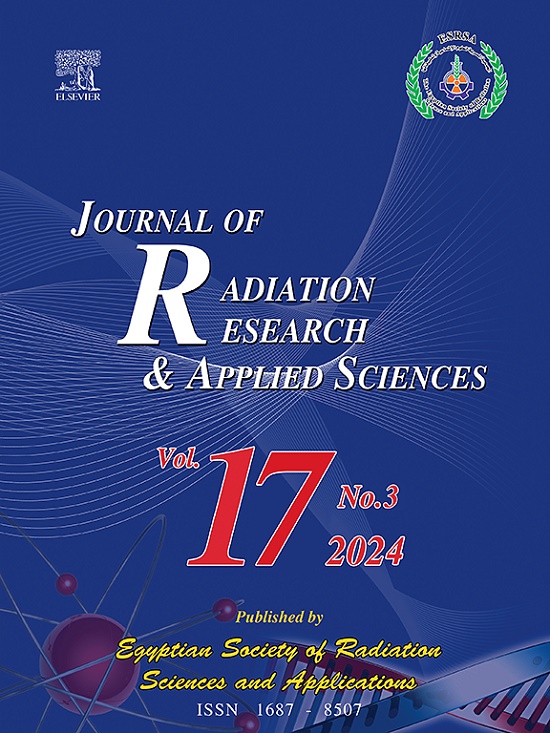Oestrogen inhibition of apoptosis causes upregulation of KLF5 and poor prognosis in female non-small cell lung cancer patients
IF 2.5
4区 综合性期刊
Q2 MULTIDISCIPLINARY SCIENCES
Journal of Radiation Research and Applied Sciences
Pub Date : 2025-06-13
DOI:10.1016/j.jrras.2025.101655
引用次数: 0
Abstract
Background
KLF5 is closely related to tumour growth, proliferation, and blood vessel formation. Our study was designed to explore the role of KLF5 in non-small cell lung cancer (NSCLC) and its impact on clinical prognosis.
Methods
Lung tissue specimens of patients diagnosed with NSCLC were collected, and KLF5 protein expression was detected in tissues. We then compared KLF5 expression levels in NSCLC patients of different sexes and its impact on clinical features using samples from the TCGA and GEPIA databases, and performed GO and KEGG enrichment analyses on KLF5, ESR1 and related genes. Finally, in vitro experiments using NSCLC PC-9 cells demonstrated estradiol mediated regulation of KLF5 expression and apoptosis were demonstrated at the cellular level.
Results
KLF5 mRNA was 2.5-fold higher in NSCLC tissues vs. adjacent tissues (p = 0.003), and protein levels increased by 1.8-fold (p = 0.01), which indicated that KLF5 was significantly over-expressed in cancerous tissues of NSCLC patients. This consistent over-expression pattern was clinically consequential, as survival analysis revealed the poor prognosis of patients was related to the over-expression of KLF5. Further analysis showed that KLF5 expression was lower in female patients than in male patients. Multivariate regression analysis showed that high KLF5 expression (HR = 1.328, p < 0.05) was an independent risk factor for lung cancer prognosis, but only in female patients. Oestrogen and oestrogen receptor inhibitors were shown to mediate KLF5 protein expression at the cellular level. In addition, with increasing concentrations of oestrogen, the expression of Bcl2 was progressively increased, the expression of Bax was progressively down-regulated, and the apoptosis of NSCLC cells decreases, and that this effect was dependent on the regulation of KLF5.
Conclusion
Estrogen upregulates KLF5, which suppresses pro-apoptotic Bax and enhances anti-apoptotic Bcl-2, reducing caspase-3 activation KLF5 may represent a potential therapeutic target for female NSCLC, warranting further preclinical and clinical investigation These findings are primarily derived from in vitro models; future in vivo studies are needed to confirm clinical relevance.

雌激素抑制凋亡导致女性非小细胞肺癌患者KLF5上调,预后不良
klf5与肿瘤生长、增殖和血管形成密切相关。本研究旨在探讨KLF5在非小细胞肺癌(NSCLC)中的作用及其对临床预后的影响。方法收集确诊为非小细胞肺癌患者的肺组织标本,检测组织中KLF5蛋白的表达。随后,我们利用TCGA和GEPIA数据库的样本,比较了不同性别NSCLC患者中KLF5的表达水平及其对临床特征的影响,并对KLF5、ESR1及相关基因进行了GO和KEGG富集分析。最后,利用NSCLC PC-9细胞进行的体外实验表明,雌二醇在细胞水平上介导了KLF5的表达和凋亡。结果KLF5 mRNA在非小细胞肺癌组织中比癌旁组织高2.5倍(p = 0.003),蛋白水平升高1.8倍(p = 0.01),表明KLF5在非小细胞肺癌患者癌变组织中显著过表达。这种一致的过表达模式在临床上具有重要意义,因为生存分析显示患者的不良预后与KLF5的过表达有关。进一步分析发现KLF5在女性患者中的表达低于男性患者。多因素回归分析显示KLF5高表达(HR = 1.328, p <;0.05)是肺癌预后的独立危险因素,但仅适用于女性患者。雌激素和雌激素受体抑制剂在细胞水平上介导KLF5蛋白的表达。此外,随着雌激素浓度的增加,Bcl2的表达逐渐升高,Bax的表达逐渐下调,NSCLC细胞的凋亡减少,这种作用依赖于KLF5的调控。结论雌激素上调KLF5,抑制促凋亡Bax,增强抗凋亡Bcl-2,降低caspase-3激活KLF5可能是女性非小细胞肺癌的潜在治疗靶点,值得进一步的临床前和临床研究。需要进一步的体内研究来确认临床相关性。
本文章由计算机程序翻译,如有差异,请以英文原文为准。
求助全文
约1分钟内获得全文
求助全文
来源期刊

Journal of Radiation Research and Applied Sciences
MULTIDISCIPLINARY SCIENCES-
自引率
5.90%
发文量
130
审稿时长
16 weeks
期刊介绍:
Journal of Radiation Research and Applied Sciences provides a high quality medium for the publication of substantial, original and scientific and technological papers on the development and applications of nuclear, radiation and isotopes in biology, medicine, drugs, biochemistry, microbiology, agriculture, entomology, food technology, chemistry, physics, solid states, engineering, environmental and applied sciences.
 求助内容:
求助内容: 应助结果提醒方式:
应助结果提醒方式:


